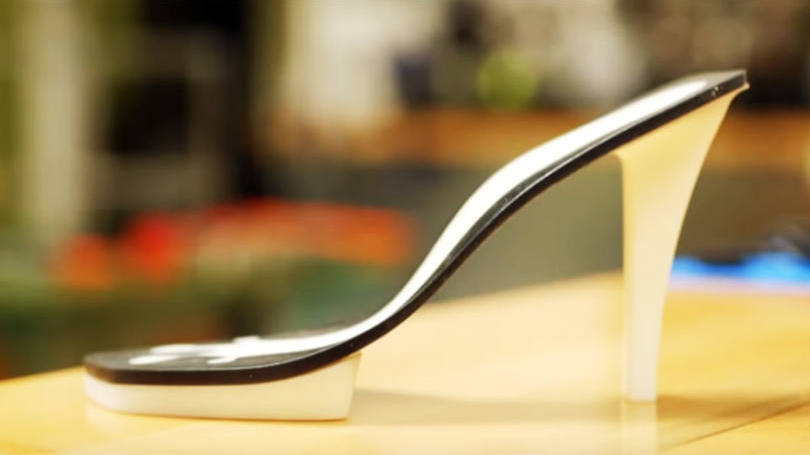Rocket scientists are making a more comfortable high heel
Before reinventing the high heel, Dolly Singh was a recruiter who brought thousands of engineers to places such as Elon Musk’s SpaceX, which is building rockets in Los Angeles. At SpaceX, Singh, 36, wore heels every day. Even though she loved pitching people on SpaceX, she started to dread taking recruits on tours of its 550,000-square-foot rocket factory.
“Once you hit 30, your body changes,” she says. “I had liked high heels since I was 17 but was starting to despise them.”
Next she did a stint at Oculus VR, a startup making a virtual-reality visor. Singh didn’t have to walk as much, but she kept thinking about heels. While at Oculus, she enrolled in the Founder Institute, a program that helps budding entrepreneurs develop their ideas. In mid-2014, Facebook bought Oculus VR for $2 billion. Singh quit to follow her passion, starting Thesis Couture and hoping to apply science to fashion. She’s not designing high heels as much as engineering them.
In hiring for Thesis, Singh has purposefully ignored people with experience in the shoe industry, instead enlisting an astronaut, a wearable-technology whiz, an orthopedist, and a materials expert. “I remember meeting Dolly for lunch and sketching some things out on napkins,” says Garrett Reisman, an astronaut Singh recruited at SpaceX. He joined Thesis as a consultant last year. “To be honest, it was pretty far afield from my interest and expertise, but once she talked about it as an engineering problem, I was hooked,” he says.
Singh’s consultants include Hans Koenigsmann, an aerospace engineer and head of mission assurance at SpaceX, and Andy Goldberg, a surgeon who specialises in the reconstruction of feet and ankles. There’s also Amanda Parkes, who has a doctorate in tangible media from Massachusetts Institute of Technology and has been at the forefront of the wearable device movement. She serves as chief technology officer at Thesis.
The high heel made its way to the Western fashion scene in the late 1500s as part of a craze for all things Persian. Those early heels were aimed at men and modeled on the riding boots of Persian cavalry. By the mid-1700s, however, they had become a woman’s shoe. Today, American women spend $20 billion annually on high heels, but the shoes haven’t been altered in a meaningful way for decades. “Given how much the rest of the world has evolved, it’s insane that high heels have not changed,” Singh says. “This is a problem that needs to be solved.”
High heels cram toes into a tight pocket, directing excessive amounts of force to the heels. Sarah Jessica Parker, who was famous for wearing them, had to swear off them after her foot rebelled by growing a protective layer of tissue. But most women have long accepted the pain. “My patients come to me and beg me to fix their feet,” says Michele Summers Colon, a podiatrist in El Monte, Calif. She recently started 34 Minute Shoes—a reference to how long women can stand in normal heels without pain—which is also rethinking the heel. “They ask me to operate on them and inject them—anything so that they can keep wearing high heels.”
34 Minute Shoes, Cole Haan, and others have focused on adding extra cushioning or creating a more customised fit around the foot. The Thesis team has zeroed in on the steel shank, a strip of metal a few inches long that's at the heart of most shoes. In high heels, its purpose is to provide the strength needed for the wearer to stand at an angle. In the 1950s, shoemakers figured out how to insert the shank into high heels and were able to make more stable products, which in turn gave rise to the stiletto. “Before that there were superskinny high heels, but they were specialty, fetish items,” says Lisa Small, the curator of exhibitions at the Brooklyn Museum, which recently ended its Killer Heels exhibit, an historical review. “It’s in the post-World War II period where you start seeing patents for these extruded metal-based stilettos.”

To modernize the shank, Singh turned to Matt Thomas, director of mechanical design at Oculus. Before joining Oculus, Thomas worked on projects that ranged from customising hot rods to engineering ballistic-grade eyewear for the military. Working as a consultant for Thesis, Thomas designed a shank made out of a plastic resin, instead of metal. The resin combines nylon with fiberglass and unlike the metal shank, doesn’t have uniform properties. It’s stiff in the middle and then has more give in the toe bed and heel to absorb impact—a mix of strength and comfort. “It’s as strong as steel in certain areas but half the weight overall,” Thomas says. “The materials also let us change the distribution load for how the foot sits in the high heel.”
When a woman is walking in high heels, the end of the stiletto jams into the ground and sends a shock up through her heel. Standing still is just as bad, because about 90 percent of the pressure is on the toes. The extra give in the Thesis shank helps spread that load by allowing the foot to sit more naturally in the shoe instead of tilting forward or backward. Around the shank, Thesis puts a rubbery material called thermoplastic polyurethane, or TPU, which replaces the cardboard that surrounds the shank in most high heels. The company also plans to create rectangular bases for its stiletto heels, in effect doubling the surface area.
Thesis faces immense challenges. Singh is basically the company’s lone full-time employee and has put $240,000 of her own money into the company and raised $500,000 from friends. It has taken months for Singh to collect ideas and craft a prototype. She expects to make 1,500 pairs this year that will cost $925 each. Eventually, Thesis plans to offer different looks—day and evening styles—and to sell the shoes at a range of prices, starting at $350.










